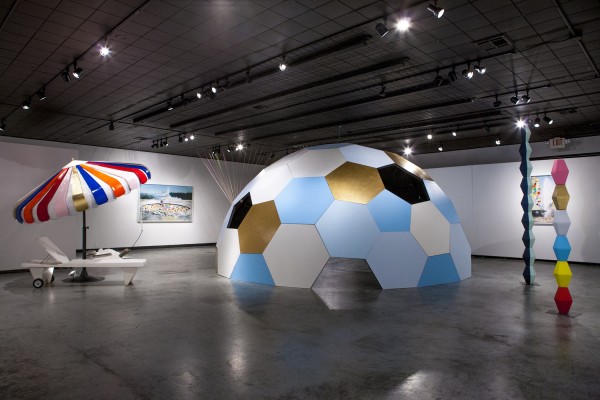At the entrance to Last Resort, a shelf holds a handful of empty wasp nests for our inspection. That is, the nests are empty of wasps. Instead, brightly colored paint fills the occasional cavity, intimating that what is growing inside is something wholly different…and perhaps even more insidious. It’s a brilliant way to start off this bright—yet oh-so dark—exhibition.

A massive, hollow dome made of large blue, white and gold hexagons fills the center of the gallery. Several hexagon tiles are missing, creating windows and an entryway on the far side of the structure. Eerie sounds emanate from speakers tucked in the cavern and more bejeweled wasp nests line the interior. The sound—both unsettling and alien—reinforces the sense of uncanniness that permeates O’Connor’s imagery. The sound filling the gallery is from the soundtrack to “The Shining.”

Monorail (2013)
Monorail (2013) deserves close study. At first glance it appears to be an innocuous image of a theme park from the 1950s, much like nearby Twirl (2013). Collaged, glittery starbursts and pastel-colored hexagons—O’Connor’s signature shape—dot the surface of the image. These rays and shapes of color and glitter naturally draw your attention first, leaving the narrative content of the scene as a secondary consideration. After a quick overview of the image, I noticed the numerous men milling about, looking in the direction of the most elaborate conglomeration of collaged rays and hexagons. Above these shapes, one monorail car dangles from the curved rail line. Only then does it become apparent that the train of these toy-like cars flew off the track and fell to the street below. The photograph doesn’t show us a typical day at an amusement park. Rather, it teases us with the grisly aftermath of the disaster. I say “tease” because glittery starbursts occlude the part of the scene that draws the attention of loitering policemen and park-goers. We aren’t able to look at the wreckage; the viewer is relegated to looking at the lookers, unable to participate in the looking itself.
Having already inspected the empty space in Bottom of the Pool #2 (2013) and the saccharine image of spinning teacups in Twirl, the recognition of the disastrous content of Monorail made me flinch. In this respect, the work is unlike any other in the exhibition.

In addition to several other collages featuring caverns, mist, geysers and pools, the exhibition includes a number of O’Connor’s sculptures, arranged around the cavernous dome. Next to Monorail sits a life-sized pool recliner and an aluminum umbrella akin to those seen in Bottom of the Pool #1 and Bottom of the Pool #3. The underside of the pink, gold, blue and orange umbrella is full of the colorful wasp nests. Given that wasps usually make their nests in hard-to-reach places that won’t be disturbed, their presence here indicates that things are not right in this world that O’Connor creates for us.
Also included in the show are two works, both Untitled (Endless column) from 2013, that are miniature versions of Brancusi’s Endless Column (1938). O’Connor’s versions are styrofoam and concrete, painted with a palette consistent with that found in her collages. To be honest, I’m not sure why these two pieces are included. They are out of step with the other work on view in terms of content, reference and style. The strength of her other sculptures lies in how, collectively, they translate her pictorial vision into three-dimensional terms.
Much of O’Connor’s imagery is pulled from popular magazines and films from the 1950s and 1960s. Though we may recognize this familiar pictoral vocabulary, we are not meant to be at ease with what we see. Indeed, the title of the exhibition, Last Resort, references the underbelly of this imagery. The hydrocarbon-like hexagons, jarringly bright colors, repetition of emptiness and manipulations of scale keep O’Connor’s works from being digested easily. Her works are both comfortably familiar and utterly foreign, and it is this dichotomy that makes studying them such a rich experience.
Last Resort is on views at Austin’s Women & Their Work gallery through May 9.
Nancy O’Connor is no relation to the artist, Kelly O’Connor.


